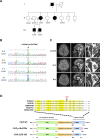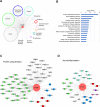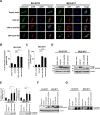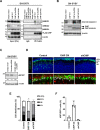Clinical and functional characterization of a novel STUB1 frameshift mutation in autosomal dominant spinocerebellar ataxia type 48 (SCA48)
- PMID: 34565360
- PMCID: PMC8466936
- DOI: 10.1186/s12929-021-00763-1
Clinical and functional characterization of a novel STUB1 frameshift mutation in autosomal dominant spinocerebellar ataxia type 48 (SCA48)
Abstract
Background: Heterozygous pathogenic variants in STUB1 are implicated in autosomal dominant spinocerebellar ataxia type 48 (SCA48), which is a rare familial ataxia disorder. We investigated the clinical, genetic and functional characteristics of STUB1 mutations identified from a Taiwanese ataxia cohort.
Methods: We performed whole genome sequencing in a genetically undiagnosed family with an autosomal dominant ataxia syndrome. Further Sanger sequencing of all exons and intron-exon boundary junctions of STUB1 in 249 unrelated patients with cerebellar ataxia was performed. The pathogenicity of the identified novel STUB1 variant was investigated.
Results: We identified a novel heterozygous frameshift variant, c.832del (p.Glu278fs), in STUB1 in two patients from the same family. This rare mutation is located in the U-box of the carboxyl terminus of the Hsc70-interacting protein (CHIP) protein, which is encoded by STUB1. Further in vitro experiments demonstrated that this novel heterozygous STUB1 frameshift variant impairs the CHIP protein's activity and its interaction with the E2 ubiquitin ligase, UbE2D1, leading to neuronal accumulation of tau and α-synuclein, caspase-3 activation, and promoting cellular apoptosis through a dominant-negative pathogenic effect. The in vivo study revealed the influence of the CHIP expression level on the differentiation and migration of cerebellar granule neuron progenitors during cerebellar development.
Conclusions: Our findings provide clinical, genetic, and a mechanistic insight linking the novel heterozygous STUB1 frameshift mutation at the highly conserved U-box domain of CHIP as the cause of autosomal dominant SCA48. Our results further stress the importance of CHIP activity in neuronal protein homeostasis and cerebellar functions.
Keywords: Ataxia; CHIP; STUB1; Spinocerebellar ataxia type 48; Tau; α-Synuclein.
© 2021. The Author(s).
Conflict of interest statement
All authors report no competing interests.
Figures






Similar articles
-
Clinical and functional characterization of a novel STUB1 mutation in a Chinese spinocerebellar ataxia 48 pedigree.Orphanet J Rare Dis. 2024 Dec 20;19(1):471. doi: 10.1186/s13023-024-03456-8. Orphanet J Rare Dis. 2024. PMID: 39707479 Free PMC article.
-
Genetic Dominant Variants in STUB1, Segregating in Families with SCA48, Display In Vitro Functional Impairments Indistinctive from Recessive Variants Associated with SCAR16.Int J Mol Sci. 2021 May 30;22(11):5870. doi: 10.3390/ijms22115870. Int J Mol Sci. 2021. PMID: 34070858 Free PMC article.
-
The complex phenotype of spinocerebellar ataxia type 48 in eight unrelated Italian families.Eur J Neurol. 2020 Mar;27(3):498-505. doi: 10.1111/ene.14094. Epub 2019 Nov 1. Eur J Neurol. 2020. PMID: 31571321
-
Spinocerebellar ataxia type 48: last but not least.Neurol Sci. 2020 Sep;41(9):2423-2432. doi: 10.1007/s10072-020-04408-3. Epub 2020 Apr 27. Neurol Sci. 2020. PMID: 32342324 Review.
-
C-terminus of Hsp70 Interacting Protein (CHIP) and Neurodegeneration: Lessons from the Bench and Bedside.Curr Neuropharmacol. 2021;19(7):1038-1068. doi: 10.2174/1570159X18666201116145507. Curr Neuropharmacol. 2021. PMID: 33200713 Free PMC article. Review.
Cited by
-
MRI Findings in a Patient with Known SCAR-16 Type STUB1 Associated Cerebellar Ataxia.J Belg Soc Radiol. 2022 Dec 14;106(1):131. doi: 10.5334/jbsr.2902. eCollection 2022. J Belg Soc Radiol. 2022. PMID: 36569391 Free PMC article.
-
The chaperone-assisted selective autophagy complex dynamics and dysfunctions.Autophagy. 2023 Jun;19(6):1619-1641. doi: 10.1080/15548627.2022.2160564. Epub 2023 Jan 3. Autophagy. 2023. PMID: 36594740 Free PMC article.
-
EGFR phosphorylates DNAJB1 to suppress α-synuclein aggregation in Parkinson's disease.NPJ Parkinsons Dis. 2025 Jun 7;11(1):157. doi: 10.1038/s41531-025-01006-y. NPJ Parkinsons Dis. 2025. PMID: 40483356 Free PMC article.
-
Combinational treatments of RNA interference and extracellular vesicles in the spinocerebellar ataxia.Front Mol Neurosci. 2022 Oct 13;15:1043947. doi: 10.3389/fnmol.2022.1043947. eCollection 2022. Front Mol Neurosci. 2022. PMID: 36311034 Free PMC article. Review.
-
A Severe Dementia Syndrome Caused by Intron Retention and Cryptic Splice Site Activation in STUB1 and Exacerbated by TBP Repeat Expansions.Front Mol Neurosci. 2022 Apr 14;15:878236. doi: 10.3389/fnmol.2022.878236. eCollection 2022. Front Mol Neurosci. 2022. PMID: 35493319 Free PMC article.
References
-
- Ballinger CA, Connell P, Wu Y, Hu Z, Thompson LJ, Yin LY, et al. Identification of CHIP, a novel tetratricopeptide repeat-containing protein that interacts with heat shock proteins and negatively regulates chaperone functions. Mol Cell Biol. 1999;19(6):4535–4545. doi: 10.1128/MCB.19.6.4535. - DOI - PMC - PubMed
MeSH terms
Substances
Grants and funding
LinkOut - more resources
Full Text Sources
Research Materials
Miscellaneous

